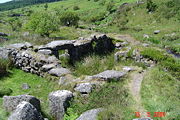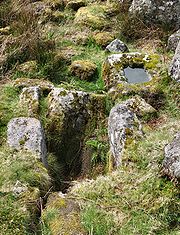
Blowing House
Encyclopedia

Smelting
Smelting is a form of extractive metallurgy; its main use is to produce a metal from its ore. This includes iron extraction from iron ore, and copper extraction and other base metals from their ores...
tin
Tin
Tin is a chemical element with the symbol Sn and atomic number 50. It is a main group metal in group 14 of the periodic table. Tin shows chemical similarity to both neighboring group 14 elements, germanium and lead and has two possible oxidation states, +2 and the slightly more stable +4...
in Cornwall
Cornwall
Cornwall is a unitary authority and ceremonial county of England, within the United Kingdom. It is bordered to the north and west by the Celtic Sea, to the south by the English Channel, and to the east by the county of Devon, over the River Tamar. Cornwall has a population of , and covers an area of...
and on Dartmoor
Dartmoor
Dartmoor is an area of moorland in south Devon, England. Protected by National Park status, it covers .The granite upland dates from the Carboniferous period of geological history. The moorland is capped with many exposed granite hilltops known as tors, providing habitats for Dartmoor wildlife. The...
in Devon, in South West England
South West England
South West England is one of the regions of England defined by the Government of the United Kingdom for statistical and other purposes. It is the largest such region in area, covering and comprising Bristol, Gloucestershire, Somerset, Dorset, Wiltshire, Devon, Cornwall and the Isles of Scilly. ...
. Blowing houses contained a furnace and a pair of bellows that were powered by an adjacent water wheel, and they were in use from the early 14th century until they were gradually replaced by reverberatory furnace
Reverberatory furnace
A reverberatory furnace is a metallurgical or process furnace that isolates the material being processed from contact with the fuel, but not from contact with combustion gases...
s in the 18th century. The remains of over 40 blowing houses have been identified on Dartmoor.
History
The blowing house method of smelting tin was probably introduced early in the 14th century to replace the earliest method of smelting which had to be done in two stages – a first smelting probably took place near to the tinworks and the roughly smelted metal was taken to a stannary town to be smelted again to produce the final refined product. Each of these smeltings was taxed separately until 1303 when they were replaced by a single tax on the finished product. It is likely that this tax change was due to the improved smelting process provided by the blowing houses.Documentation confirms the existence of blowing houses in Cornwall as early as 1402, but the earliest reference for Dartmoor is not found until the early 16th century, though it is likely that they were in use on the moor earlier. In Devon there are many references to blowing mills throughout the 16th and 17th centuries, reflecting the boom time in tin-mining on Dartmoor. However by 1730 there were only two blowing mills working in the whole of the county: at Sheepstor and Plympton.
From the beginning of the 18th century, this method was gradually superseded by reverberatory furnace
Reverberatory furnace
A reverberatory furnace is a metallurgical or process furnace that isolates the material being processed from contact with the fuel, but not from contact with combustion gases...
smelting, which used higher temperatures and powdered anthracite as fuel and had the advantage of not requiring a forced draught of air. The smelting house at Eylesbarrow tin mine which was in operation during the first half of the 19th century had two furnaces, one of each type.
Construction
On Dartmoor, blowing houses were rectangular buildings between around 16 to 32 ft (4.9 to 9.8 ) in length and around half this in width. They were made of unmortared granite blocks with walls often 2 in 6 in (0.762 m) or more thick and probably had turf or thatch roofs which were periodically burnt to retrieve the particles of tin that would have been driven into the roof through the blast from the bellows. Blowing houses are typically located on or near the bank of a stream where the fall of water was enough for a leat to be built to work a small (9 ft (2.7 m)) diameter overshot water wheelWater wheel
A water wheel is a machine for converting the energy of free-flowing or falling water into useful forms of power. A water wheel consists of a large wooden or metal wheel, with a number of blades or buckets arranged on the outside rim forming the driving surface...
which developed around 0.66 hp to operate the bellows.
The only contemporary detailed description of a blowing house was provided by a Cornishman named William Pryce in his treatise on Cornish mining of 1778:
According to Crispin Gill, about two tons of charcoal
Charcoal
Charcoal is the dark grey residue consisting of carbon, and any remaining ash, obtained by removing water and other volatile constituents from animal and vegetation substances. Charcoal is usually produced by slow pyrolysis, the heating of wood or other substances in the absence of oxygen...
was needed to smelt a ton of metal. The molten metal ran out from the bottom of the furnace into a granite trough or "float" from where it was ladled into stone moulds.
Archaeology
Archaeological investigation of blowing houses started in 1866 when John Kelly examined the lower mill at Yealm Steps. Robert Burnard cleared the interior of the lower mill at Week Ford in the 1880s, but the most notable researcher of the remains on Dartmoor was R. Hansford Worth who made detailed records of over 40 sites. Since then, research on the tin industry in the south west has continued, for instance The Dartmoor Tinworking Interest Group was formed in 1991.
Merrivale, Devon
Merrivale is a locality in western Dartmoor, in the West Devon district of Devon, England. It is best known for the nearby series of Bronze Age megalithic monuments to the south and a former granite quarry.-Merrivale hamlet:...
, Avon Dam and Blacksmith's Shop. Each of these sites has two upright granite slabs about 2 to 3 ft (0.6096 to 0.9144 ) apart set into the floor area of the mill, leaving space behind for the bellows. The Merrivale sites also have a slab at the back, making a basic hearth shape. The accompanying photograph shows the two side slabs of the furnace at the Lower Merrivale blowing house, with the somewhat displaced float stone between them. The mouldstone, filled with rainwater, is just above and to the right.
The mouldstone is the best field evidence for a blowing house; they are large blocks of granite with a flat top containing a rectangular hollow recess into which the molten tin was poured to be cast into ingots. The moulds vary in size and shape, the largest known from Dartmoor being that from Upper Merrivale at 280 by 390 mm (11 by 15.4 ), and the smallest 180 millimetres (7.1 in) square at Longstone. Some mouldstones have additional smaller hollows on their surface; these are traditionally assumed to be for assaying purposes, but some authors have suggested that they may have been for making small ingots for selling illicitly to avoid tin coinage
Tin coinage
In Devon and Cornwall, tin coinage was a tax on refined tin, payable to the Crown and administered in the Stannary Towns. The oldest surviving records of coinage show that it was collected in 1156. It was abolished in 1838....
, the tax on white, or refined tin
White tin
White tin is refined, metallic tin. It contrasts with black tin, which is unrefined tin ore as extracted from the ground. The term "white tin" was historically associated with tin mining in Devon and Cornwall where it was smelted from black tin in blowing houses....
.
The only properly documented find of a tin ingot from Dartmoor has a diagonal hole through it which matches the supposed practice of placing a stick in the mould when pouring in the molten tin. The stick would burn away leaving the hole which would be used to lever out the solid ingot from the mould and would later be useful to tie up the ingots for carriage. According to Worth, the found ingot fitted precisely into one of the moulds found at the lower blowing house on the River Yealm
River Yealm
Yealm is a river in Dartmoor in Devon in south-west England. It rises 1,411 feet above sea level on the Stall Moor mires of south Dartmoor and makes a 12 mile journey to the sea, passing through Cornwood, Lee Mill and Yealmpton, before reaching the estuary mouth just below Newton Ferrers and Noss...
, although it did not fill it and weighed only 52 pounds (23.6 kg), far less than the average Dartmoor ingot weight of 195 pounds (88.5 kg). He speculated that it was the small surplus that remained after the normal ingots had been cast. Cornish ingots were much larger, averaging around 345 pounds (156.5 kg).
One of the best preserved blowing houses on Dartmoor is above Merrivale
Merrivale, Devon
Merrivale is a locality in western Dartmoor, in the West Devon district of Devon, England. It is best known for the nearby series of Bronze Age megalithic monuments to the south and a former granite quarry.-Merrivale hamlet:...
Bridge on the River Walkham
River Walkham
The Walkham is a river whose source is on Dartmoor, Devon, England. Flowing under Merivale and Huckworthy Bridges, the river reaches Horrabridge. About three miles further on, by a footbridge on the West Devon Way, it joins the River Tavy.-See also:...
. It has a mould stone close to its entrance and the wheel-pit can be easily traced. Some blowing houses also housed crushing ("knacking") or grinding ("crazing") mills, and at Gobbet Mine on the River Swincombe
River Swincombe
The River Swincombe is a tributary of the West Dart Riveron Dartmoor in Devon in south-west England. It rises south-east of Princetown, and flows 2 km south-east to Foxtor Mires, where it turns north-east to meet the West Dart near Hexworthy. The first 2 km are known as the Strane River.-...
both the upper and lower grinding stones were found.
Further reading
- Bryan Earl Cornish mining: the techniques of metal mining in the West of England, past and present; 2nd edition; Cornish Hillside Publications, 1994. ISBN 0-9519419-3-3.pp. 97, 97.1 with illustration.

